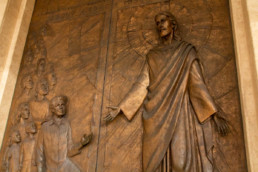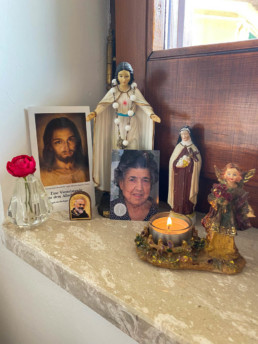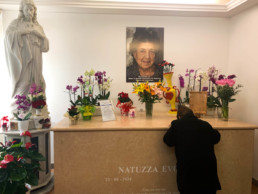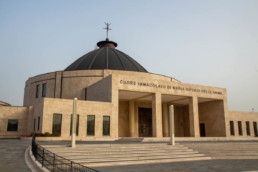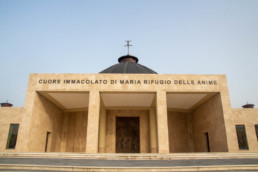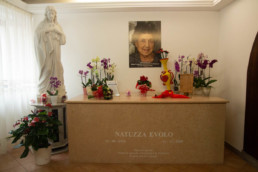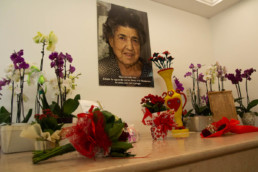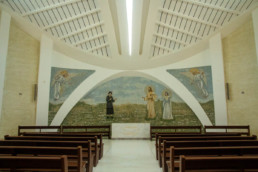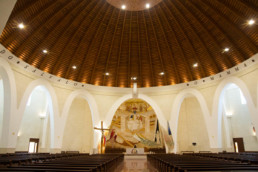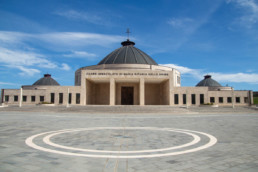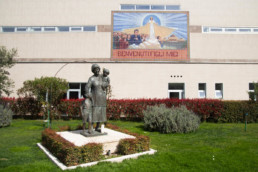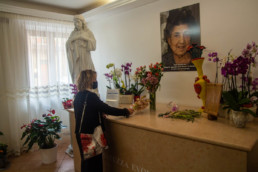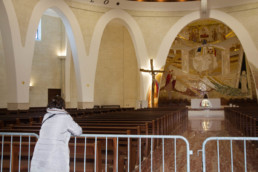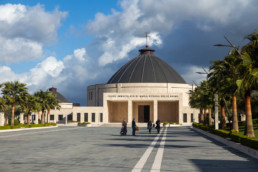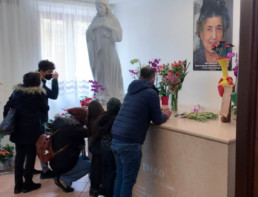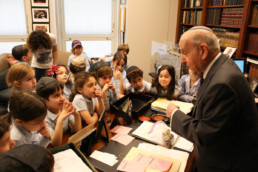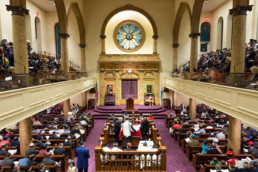A Great Mystic of our Time: Natuzza Evolo and the Catholic Church
Paravati, ITALY – When Fortunata Evolo, a 20th Century Italian mystic, was alive, thousands would come to this little village in Calabria to seek her guidance, inspiration and healing. She claimed to have apparitions of Jesus and Mary and said that she was able to communicate with the dead.
After her death in 2009, the pilgrims kept coming, declaring that she continued to perform miracles from her heavenly abode. They prayed at her tomb and finished building the “Villa of Joy,” a complex of buildings that Evolo said appeared to her in a vision. In 1944, she said, the Virgin Mary told her to build a church, a youth center and a senior center to help the people in need.
Evolo, known as “Mom Natuzza” by the faithful, is more than a local hero. Devotees all around the world, especially in Italian immigrant communities, have photos of her on their bedside tables and recite the rosary following her teachings.
Natuzza was treated as if she were a saint of the Catholic Church. In reality, she is not, but the Vatican is conducting a process whereby she may become one in the future.
Her cause for sainthood officially began three years ago, on April 6, 2019, when the Vatican initiated the process, which will conclude when the Congregation for the Cause of Saints decides on her sanctity or not. These proceedings are usually very long; the one for Saint Pius’ took 19 years.
The Vatican appointed an ecclesiastical tribunal to ascertain Natuzza’s alleged spiritual gifts during this very delicate process. “An ecclesiastical tribunal was set up to gather testimony and acquire documentation to make her a saint,” said Pasquale Anastasi, the Immaculate Heart of Mary Refuge of Souls Foundation president.
However, it seems that the faithful do not need an official declaration from the Vatican to recognize the spiritual powers and gifts of Natuzza. They continue to flock every year to Paravati, in the region known as Calabria, to pray for her intercession.
I grew up making regular visits to Calabria. I know the region and the unique religious dedication of the people who live here very well. This spring, I set out to explore the Natuzza causes. I traveled to Paravati and Mileto, visiting the places where Natuzza lived and professed her faith, spending her life in the service of others. Among these places is the “Villa of Joy,” which is formed by the church dedicated to the Immaculate Heart of Mary Refuge of Souls, a rest home, and a center for young people built according to Natuzza’s wishes. She said that the Virgin Mary herself told her just what the architecture of the church should look like, together with the other buildings of the Villa.
“There will be a large new church called the Immaculate Heart of Mary Refuge of Souls and a home to alleviate the young, the elderly, and those others who find themselves in need.” These were the words that Natuzza said were told to her by the Virgin Mary in 1944 and that are part of her spiritual testament.
Natuzza was like a mother to many and a spiritual guide to shelter from suffering. On this trip, I learned about the many paranormal experiences associated with her, the great humility she is remembered by the faithful, and the various misunderstandings that arose around her figure that led to her being locked in an asylum as a child and undergoing an exorcism, according to the testimonies.
Natuzza lived in Paravati from her birth in 1924 until her death 85 years later on November 1, 2009. Belonging to a large family that could not afford to send her to school, she grew up as an illiterate woman without religious instruction. Despite this, “she knew the catechism better than I did, who was her parish priest,” said the Rev. Don Pasquale Barone, 83, one of the two spiritual fathers who accompanied her throughout her life. “She had been taught everything directly by Jesus and the Virgin Mary,” he concluded while we were in one of the rooms of the foundation’s building inside the “Villa of Joy.” There, Barone spends most of his time, since it gives him a feeling of peace and serenity.
According to Paravati’s community and the people who have always remained close to her, like Barone, Natuzza has always been a poor and modest woman. Phenomena that cannot be explained scientifically were associated with her, making Natuzza, in the words of Barone, “a great mystic of our time.” And only mysticism could explain how an illiterate woman could hold conversations with university professors and academics, he said.
However, things around her figure and the spiritual guidance Natuzza left when she died have not always gone smoothly. According to Barone, in 2017, the bishop of Mileto, Luigi Renzo, prohibited Natuzza’s foundation from holding masses in the Immaculate Heart of Mary Refuge of Souls’ church due to some disagreements on who was to take care of Natuzza’s will. The church was already completed in July 2016, but the masses were forbidden to be held because of these problems. “We had a three-year ban on worship activities,” Anastasi said. Following the Vatican’s intervention, Pope Francis installed a new bishop last year, Bishop Attilio Nostro.
The church Immaculate Heart of Mary Refuge of Souls will be consecrated and officially opened for worship by the faithful this summer, an event for which pilgrims worldwide are expected.
Among the numerous phenomena connected to her were the apparitions of Jesus, the Madonna, angels, saints, and the dead, which the Church initially saw as symptoms of madness or the devil. According to Barone, Natuzza was exorcized when she was young and sent to an asylum. However, the apparitions did not disappear, and over the years the Church began to reassess its opinion of Natuzza.
Also linked to Natuzza was bilocation – being in two places simultaneously -, and the formation of stigmata on her skin during Holy Week. “According to us (the sores) were her participation in the suffering of Christ,” said Father Michele Cordiano, 64, while sitting on a bench in front of the Immaculate Heart of Mary Refuge of Souls Church. He is the other priest who was close to Natuzza for years and witnessed these events firsthand. “But the strongest suffering was the one she lived inwardly,” referring to Natuzza’s sharing Jesus’ suffering caused by the atrocities that affect humanity.
Several testimonies also attributed to her the ability to diagnose exact diseases and suggest the best treatment. “She would appear to us in dreams and tell us the medicines Francesco needed to take, and we would report to the doctors. And she was always right,” Natalina Scuteri, the mother of a young man named Francesco Fogliaro, told me.
After a severe motorcycle accident in 2007, Fogliaro was in a vegetative coma for two months. According to Scuteri, even his awakening was the work of Natuzza, who had reassured her that her son would survive. Scuteri said she strongly opposed the doctors when they wanted to disconnect the machines that kept Fogliaro alive during his coma because Natuzza told her to do so. “Thanks to Mom Natuzza, Francesco is alive.”
Like Scuteri, thousands came to Natuzza or for medical advice, or to get in touch with the deceased, or even for the sole purpose of receiving words of encouragement in difficult times. According to the Rev. Cordiano, Natuzza would welcome approximately 300 people a day into her humble home in Paravati. “She always wanted to speak face to face with people, never in public. So it remained a very confidential dialogue,” he said.
Cordiano explained her appeal. “People felt accompanied by the wisdom of the things Natuzza offered and the certainty that her prayer was true. It was an accompaniment, always so that the person would find serenity and find peace and balance. (…) They felt taken by the hand of a mother.”
And it is this gentleness in guiding people and her humility that is remembered first. “The impression she left was that of a mother who had just welcomed a family member, a child, into a dialogue that was often dramatic in tone, but the outcome was always a rebirth,” said Bishop Nostro. “The encounter with her was to the core an Easter encounter.”
Still today, Natuzza assumes the role of spiritual guide not only for the pilgrims who go to the small village of 6,500 people to pray at her tomb. Prayer groups dedicated to her are worldwide, formed mainly through Italian immigrant communities. “Here in Italy, there are about 400 prayer groups,” said Cordiano. “In Long Island in New York, there are perhaps more than twenty, two in Australia in Sydney and Adelaide and some in Toronto.” According to him, the formation of these groups “is an invitation to recover the dimension of the community of faith, and feel the presence of God.”
Emerita Cretella, an Italian anthropologist, defines Natuzza as a “living ritual” in the experience of Catholicism since she generates a change in the person. The individual who suffers the disintegration of today’s society asks for help from Natuzza, who helps in their reconstruction process. According to Cretella, the figure of Natuzza, seen as a spiritual intermediary and a point of conjunction with the divine, is a reassurance for the person.
Valerio Marinelli, former professor of technical physics at the University of Calabria and nuclear engineer, has studied the “Natuzza phenomenon” since 1976, interviewing thousands of people and investigating mainly the alleged bilocation of the Calabrian mystic. Initially skeptical about the truthfulness of the phenomena associated with her, Marinelli, after hearing the numerous testimonies, has reconsidered his opinion.
Marinelli has published 12 books in which he speaks about Natuzza. The eleventh contains only testimonies of doctors who “have both verified in person that the mystic phenomena linked to Natuzza were not scientifically explainable,” he said.
“There is not a day that I do not invoke Mom Natuzza. I call on her to assist me in family problems, on children, on the sick and people in need,” Anastasi said.
“Through the saints, Jesus continues to manifest himself in some way. The saints are a model for us who accompany us in life,” Marinelli said. “They are a model, intercessors with the divine, and they help us.”
Meanwhile, the cause to verify Natuzza’s sanctity ordered by the Vatican continues.
No one is expecting it to be completed this summer. Meanwhile, on May 8th, the day of the mother and the Virgin Mary in the Roman Catholic Church, a mass dedicated to “Mom” Natuzza will be held in Paravati. Similarly, on May 15th, a mass in Italian dedicated to her and the Virgin Mary will occur at St. Rocco Parish in Glen Cove. There, 25 years ago, was founded one of New York’s cenacles dedicated to Natuzza.
“For me, she is a saint; for me, there is no need for her to be declared and put on the altar. Because she was a humble person, and when she looked at you with those eyes, she read your soul and heart,” said Josephine Carbone, a Long Island resident, who met Natuzza almost 55 years ago and never let her go.
The Meaning of Purim, the Jewish Identity
On Saturday evening, the Orthodox Jewish community of the Congregation Kehilath Jeshurun gathers in the Synagogue to close Shabbat with a Havdalah blessing.
Halfway through the service, one rabbi gives a pre-printed source sheet to each synagogue member. Rachel Kraus leaves her seat in the women's section and steps to the front of the synagogue audience. She cautiously removes her face mask to make her voice echo throughout the room as she adjusts her long dress and begins the sermon.
She encourages the faithful to use the 30 days between now and Purim to reflect on the nuances of the holiday. Purim is the 15th day of Adar and is a holiday for Jews to be happy. According to the book of Esther, in the 5th century BCE, the Jews survived after the Persian rulers ordered to kill them, and Purim was the day when they celebrated their salvation.
Kraus vigorously explains to the congregation her interpretation of Purim and what this holiday indicates about Jewish identity. To do so, she uses 13 texts that are listed on the source sheet.
"Just as with the beginning of Av, rejoicings are curtailed, so with the beginning of Adar rejoicings are increased" (Talmud Masechet Ta'anit 29a). This is the first source in Kraus' collection. She explains to the congregation that Purim contrasts with the month of Av, which represents disruption and is seen as the lowest and saddest time in Judaism. Both temples in Jerusalem were destroyed during this month, and other calamities struck the Jews.
On the contrary, Purim is a happy and festive day. However, Kraus mentions that there are phrases and passages in the biblical and historical Jewish texts where this day does not seem so happy. The question, then, is whether Purim is a joyful day or not. Kraus answers that it is both, and it is a moment when we need to take a deep look inside ourselves.
According to Kraus, one must use the month of Av as a counterpoint to make the best of the day of Purim and be happy. The believer is called upon to understand whether they are giving attention to the right things or taking the wrong path. She says that this idea also defines Jewish identity as a community that always looks to its past to know how to face the future; "These days of Purim shall never be repealed among the Jews, and the memory of them shall never cease from their descendants." (Esther 9:28) Jews must always have their entire journey in mind. "(Purim) Help us go in the right direction," says Kraus.
The congregation listens in respectful silence to Kraus' words. Everyone is seated with their gazes turned toward her. This is one of the only moments when no one speaks or prays simultaneously, as it sometimes happens during the intonation of the hymns.
Even the children who usually do not actively follow the evening services are now sitting and listening to the young woman's words in front of the congregation, who encourage the faithful to reflect. There are about 50 men and a dozen women in the synagogue, and they all follow closely, nodding when they recognize themselves in Klaus' explanations of the Talmud.
Kraus ends her sermon; Purim is not just a happy holiday. It is a day when the faithful reflect on their past to make the right choices in the future. "When we forget where we come, we forget where we go," she recalls.
The congregation thanks Kraus by saying "Shabbat Shalom," and she returns to the midst of the women, who greet her with congratulations.
The faithful pass around the Havdalah spice box, and each member of the congregation sniffs it to give themselves energies for the next week until the following Shabbat. The rabbi blows out the candles. The service is over, and with it, the Shabbat.
Shuckling In A Modern Orthodox Synagogue
I do not know what time it is when Cantor Chaim Dovid Berson begins to sing the Amidah, or Shemoneh Esreh, which is the central part of the Jewish prayer. It is a prayer recited three times a day - morning, afternoon and evening - in Orthodox Jewish communities.
On this Friday evening, I attend Ma'ariv, the Jewish service recited after the sunset. I am in the Orthodox Jewish synagogue of Congregation Kehilath Jeshurun, located at 125 E. 85th St. on the Upper Eastside of Manhattan. No cell phones or other electronic devices are allowed here; that's why I don't know what time it is. This is a sacred place where the faithful share a moment of prayer with the community, and I understand that cell phones would distract people from this purpose.
Men and women sit separately in the synagogue, and I join the few women present. It is the first time I have ever visited a synagogue and the first time I have ever attended a service. I look around. The men are dressed in a jacket and tie and wear the kippah, a brimless cap worn as a sign of respect. The women are elegantly dressed. The rabbi is in the center of the room on the bima, a raised platform. He chants and the rest of the congregation sometimes joins the intonation of the hymn.
When the prayer intensifies, and voices rise, the faithful begin to rock. The hands either go down the body or hold the prayer book; the feet are stuck to the ground. Some go back and forth, some go from side to side, and some make a deep bow at the end of the swaying motion. This movement is called “shuckling,” which comes from the Yiddish word that means "to shake." It is a profoundly private moment between the faithful and their prayer, and each person takes as much time as they need to make this movement.
While the faithful continue to shuckling, I observe them in silence. It almost seems like I can see the energy pouring out of their bodies and pervading them. Quickly, I realize that there is not a time when the worshippers are called to make that movement. The person begins to rock back and forth at their discretion, when they want to, and without needing someone to tell them to do so. Everything seems spontaneous and authentic.
Next to me, a girl named Mia is particularly focused in prayer as she moves her body back and forth, occasionally making a deep bow. At the end of the service, she tells me that that movement is her way of praying, and there is no precise explanation behind this gesture.
According to Rabbi Chaim Steinmetz, the swinging represents the total immersion of the believer's energy in prayer. He also jokingly tells me that it is a movement-related only to Jews, particularly Orthodox Jews, and that the Prophet Mohammed is said to have warned his adherents "not to do like Jews who move back and forth."
There is also another explanation of shuckling that can be found in the past, according to an article written in 2013 by Miriam Goldmann, curator of the Jewish Museum Berlin’s exhibition “The Whole Truth.” In the 12th century in Spain, Rabbi Yehuda Halevi reported that often the Torah was read by many men at the same time. To ensure that the process was quick, they developed this movement whereby they would bend forward to see the book and then quickly retract to make room for the faithful afterward.
However, the service is now over. I gather my things and present myself to the rabbis. Meanwhile, the community members greet each other by saying "Shabbat Shalom," which is an invitation to enjoy a blessed Shabbat. I greet everyone by thanking them, and as a response, I receive a warm "Shabbat Shalom, Eleonora.”

